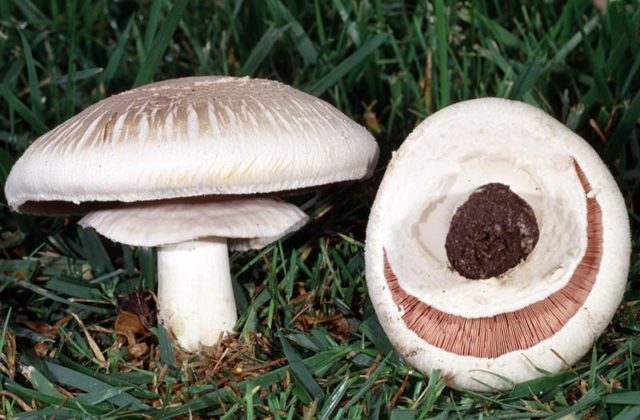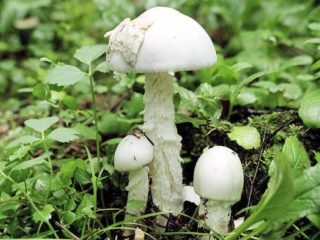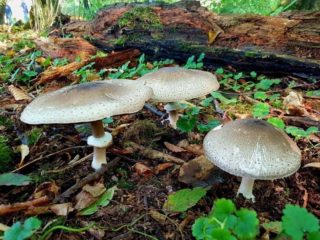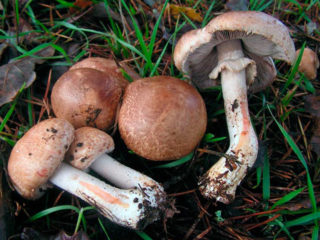Content
Rare mushrooms that grow in the steppes and deserts of Asia are tabular champignons. The Latin name of the species is Agaricus tabularis. On the European continent, they are found only in the steppes of Ukraine.
What does tabby mushroom look like?
It is a small, rounded mushroom, the fruiting body of which consists of 90% of the cap. Its diameter ranges from 5 to 20 cm, depending on the degree of maturity of the fungus. In young specimens, the cap is rounded, later it becomes flat-convex. Its surface is uneven, covered with gray crusts and scales. As it ripens, it cracks and is distributed into pyramidal cells. Its color is light gray or off-white. The edge of the cap is wavy, tucked up, becomes extended over time, the remains of the bedspread remain on it.

The hat is thick, fleshy, spherical
The pulp is dense, whitish, turns yellow when pressed. May turn slightly pink with age. Dried champignon tabular yellow.
The leg is flat, wide, dense, cylindrical in shape, fixed in the center of the cap, it tapers slightly towards the bottom. Its entire surface and interior is white. The length of the leg does not exceed 7 cm, the diameter is 3 cm. The surface is velvety, fibrous. The thick apical ring on the pedicle is smooth at first, later becomes fibrous or drooping.
The blades of the tabular champignon are narrow, of medium frequency, at first creamy white, at full maturity they become brown or black. They usually do not grow to the leg. In young fungi, the lamellar layer is hidden under a thin blanket in the form of a white film.
Where does tabby mushroom grow
This rare species is found in the arid semi-deserts of Kazakhstan and Central Asia. In Europe, it grows only in the steppe zone of Ukraine (Donetsk, Kherson regions), in reserves: Askania-Nova, Streltsovskaya steppe, Khomutovskaya steppe. The mushroom is listed in the Red Book. You can find the tabular mushroom in North America, in the prairies of Colorado and in the desert of Arizona.
Fruiting from June to October, prefers dry, open to the sun glades. The mycelium is located in the upper soil layers.
Is it possible to eat tabular champignon
In Russia, the tabular mushroom is practically not found, rare specimens can be found on the territory of the Crimea. Presumably, the mushroom is considered edible, but due to its small number, there is no confirmed data on its safety.
False doubles
The tabular mushroom has several inedible cousins. It is important to study their description so as not to be mistaken with the choice.
Red champignon (yellow-skinned peppers) is a poisonous mushroom, similar to many other representatives of the species. Poisoning them leads to serious consequences.
Its distribution area is extensive - it is found almost all over the world. It grows in forests, on lawns, in meadows overgrown with grass. The mushroom bears fruit especially abundantly after rain in late summer or early autumn.
The chives have a more open hat with a gray spot in the center. When pressed, it turns yellow. In old mushrooms, the leg darkens at the base.

Red champignon - a larger specimen than tabular
You can distinguish it from the tabular champignon by the ring, which is located almost in the center of the leg. It is fleshy, two-layered, wide, white.
In the process of thermal exposure, the yellow-skinned peasant exudes an unpleasant chemical odor.
The flat-headed champignon is a poisonous mushroom, the size of which is smaller than the described rare brother. The diameter of the cap of the twin does not exceed 9 cm. In young specimens, it is bell-shaped; with age, it becomes prostrate, but a noticeable bulge of dark color remains in the center.

The surface of the cap is cream or gray, the scales are small, poorly expressed
The flat-leaf mushroom grows in deciduous or mixed forests. You can also find it on pastures in dense grass.
An important difference: the leg of the poisonous twin does not narrow downwards, but expands, at the end it has a tuberous growth. There is a noticeable white ring in the upper third of the peduncle.
When pressed, the pulp emits an unpleasant chemical odor, it is compared to a pharmacy one.
Collection rules and use
You can find tabular mushrooms in the vastness of semi-deserts or virgin steppes. The white fruiting body of the fungus is clearly visible among the yellowing grass. The mushroom grows singly or in small groups. It is carefully cut or twisted from the mycelium.
Since there is no data on the safety of the described species for human health, it is not recommended to prepare it for eating.
Conclusion
Champignon tabular is a rare representative of the Champignon family. In some countries, it is listed in the Red Book, since it is practically not found on the European continent. More often you can find a tabular mushroom on the territory of Central Asia, in the deserts and semi-deserts of Kazakhstan. The extinction of the species is associated with the plowing of virgin steppes for pasture and the fall of grass.








